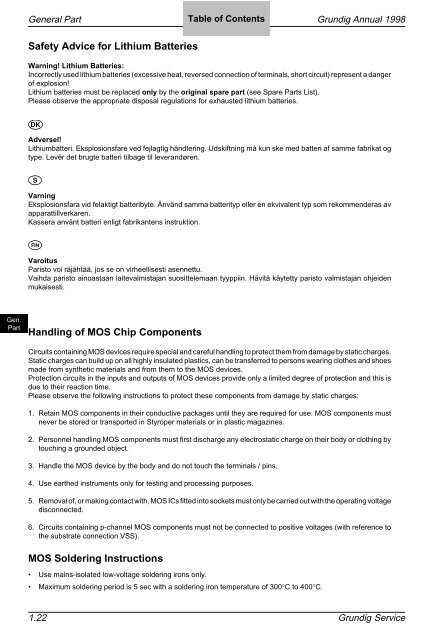1998 - Free
1998 - Free
1998 - Free
Create successful ePaper yourself
Turn your PDF publications into a flip-book with our unique Google optimized e-Paper software.
Gen.<br />
Part<br />
General Part Grundig Annual <strong>1998</strong><br />
Safety Advice for Lithium Batteries<br />
Warning! Lithium Batteries:<br />
Incorrectly used lithium batteries (excessive heat, reversed connection of terminals, short circuit) represent a danger<br />
of explosion!<br />
Lithium batteries must be replaced only by the original spare part (see Spare Parts List).<br />
Please observe the appropriate disposal regulations for exhausted lithium batteries.<br />
Adversel!<br />
Lithiumbatteri. Eksplosionsfare ved fejlagtig håndtering. Udskiftning må kun ske med batteri af samme fabrikat og<br />
type. Levér det brugte batteri tilbage til leverandøren.<br />
s<br />
Varning<br />
Eksplosionsfara vid felaktigt batteribyte. Ånvänd samma batterityp eller en ekvivalent typ som rekommenderas av<br />
apparattillverkaren.<br />
Kassera använt batteri enligt fabrikantens instruktion.<br />
ß<br />
Varoitus<br />
Paristo voi räjähtää, jos se on virheellisesti asennettu.<br />
Vaihda paristo ainoastaan laitevalmistajan suosittelemaan tyyppiin. Hävitä käytetty paristo valmistajan ohjeiden<br />
mukaisesti.<br />
Handling of MOS Chip Components<br />
Circuits containing MOS devices require special and careful handling to protect them from damage by static charges.<br />
Static charges can build up on all highly insulated plastics, can be transferred to persons wearing clothes and shoes<br />
made from synthetic materials and from them to the MOS devices.<br />
Protection circuits in the inputs and outputs of MOS devices provide only a limited degree of protection and this is<br />
due to their reaction time.<br />
Please observe the following instructions to protect these components from damage by static charges:<br />
1. Retain MOS components in their conductive packages until they are required for use. MOS components must<br />
never be stored or transported in Styroper materials or in plastic magazines.<br />
2. Personnel handling MOS components must first discharge any electrostatic charge on their body or clothing by<br />
touching a grounded object.<br />
3. Handle the MOS device by the body and do not touch the terminals / pins.<br />
4. Use earthed instruments only for testing and processing purposes.<br />
5. Removal of, or making contact with, MOS ICs fitted into sockets must only be carried out with the operating voltage<br />
disconnected.<br />
6. Circuits containing p-channel MOS components must not be connected to positive voltages (with reference to<br />
the substrate connection VSS).<br />
MOS Soldering Instructions<br />
• Use mains-isolated low-voltage soldering irons only.<br />
• Maximum soldering period is 5 sec with a soldering iron temperature of 300°C to 400°C.<br />
1.22 Grundig Service


